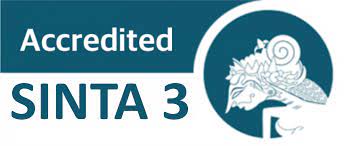The Appearance of Social Reality in The Dancer Ahmad Tohari by Rene’ TA Lysloff
Abstract
Keywords
Full Text:
PDFReferences
Aditya, Rahadiyanti and Achmad Basari. 2013. The Ideology of Translation of Cultural Terms Found in Ahmad Tohari’s Novel “Ronggeng Dukuh Paruk” into Its English Version “The Dancer” http://eprints.dinus.ac.id/8193/1/jurnal_12158.pdf (retrieved on November 6, 2020).
Djojosuroto, Kinayati. 2006. Analisis Teks Sastra dan Pengajarannya. Yogyakarta: Penerbit Pustaka.
Endraswara, Suwardi. 2011. Metodologi Penelitian Sastra; Epistemologi, Model, Teori, dan Aplikasi. Yogyakarta: Caps.
Faruk. 1999. Pengantar Sosiologi Sastra. Yogyakarta: Pustaka Pelajar.
Najid, Moh. 2003. Mengenal Apresiasi Prosa Fiksi. Surabaya: University Press.
Nurgiyantoro, Burhan. 2005. Teori Pengkajian Fiksi. Yogyakarta: Gadjah Mada University Press.
Ratna, Nyoman Kutha. 2003. Paradigma Sosial Sastra. Yogyakarta: Pustaka Pelajar.
Sangidu. 2004. Penelitian Sastra: Pendekatan, Teori, Metode, Teknik dan Kiat. Yogyakarta: Seksi Penerbitan Sastra Asia Barat. Fakultas Ilmu Budaya. Universitas Gadjah Mada.
Semi, M. Atar. 1984. Kritik Sastra. Bandung: Angkasa.
Semi, M. Atar. 1993. Metode Penelitian Sastra. Bandung: Angkasa.
Semi, M. Atar. 2003. The Dancer. Translated by Rene TA. Lysloff. Jakarta: The Lontar Foundation.
Setyosari, Punaji. 2010. Metode Penelitian Pendidikan dan Pengembangan. Jakarta: Kencana.
Sumaryadi, I Nyoman. 2015. Teori Ilmu Sosial. https://www.slideshare.net/DIP_3/teori-ilmu-sosial-s3-615-prof-nyoman (retrieved on November 6, 2020).
Tohari, Ahmad. 2011. Dancer Dukuh Paruk. Jakarta: Gramedia Pustaka Utama.
Waluyo, J Herman.2006. Pengakajian dan Apresiasi Prosa Fiksi. Surakarta: UNS Press.
DOI: https://doi.org/10.18860/abj.v6i1.11470
Refbacks
- There are currently no refbacks.
Copyright (c) 2021 Abjadia

This work is licensed under a Creative Commons Attribution-NonCommercial 4.0 International License.
...............................................................................................................................................................
Mailing Address:
Ruang Jurnal Abjadia, Fakultas Ilmu Tarbiyah dan Keguruan (FITK)
Universitas Islam Negeri (UIN) Maulana Malik Ibrahim Malang
Jalan Gajayana 50 Malang 65144, Jawa Timur, Indonesia
Phone/Faximile: (+62341) 552398, Phonsel: +6281333666063
Website: http://ejournal.uin-malang.ac.id/index.php/abjadia
Email: abjadia@uin-malang.com
Abjadia: International Journal of Education. This work is licensed under a Creative Commons Attribution-ShareAlike 4.0 International License.
...............................................................................................................................................................
Indexed by:






